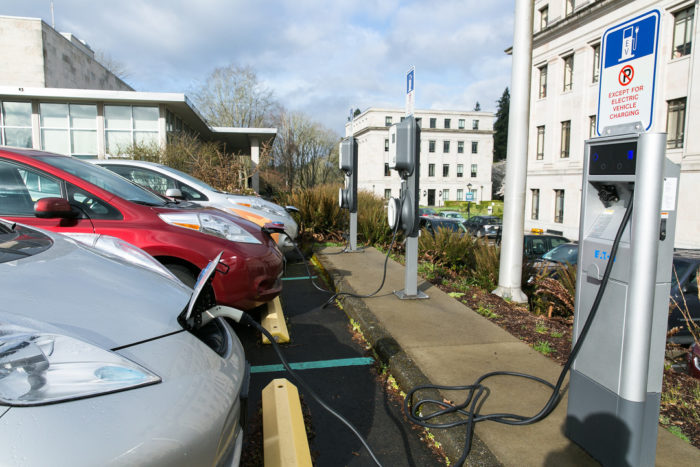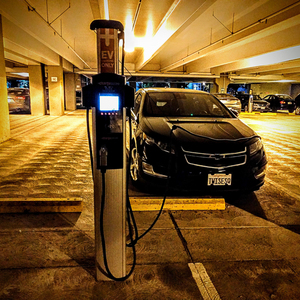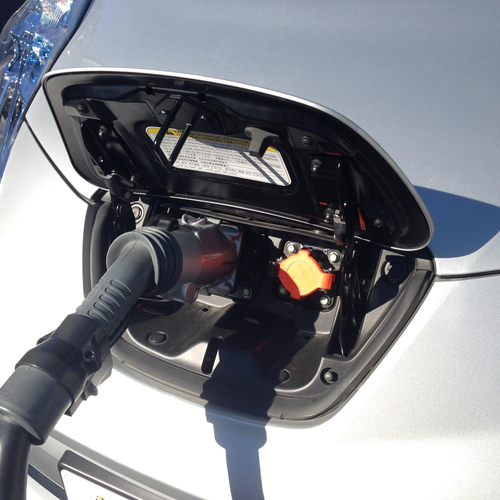
Image Credit: CC BY-ND 2.0 / Flickr
BY CHRIS NELDER
If you think electric vehicles are still a niche technology, think again. The International Energy Agency (IEA) estimates that more than 1 million electric vehicles (EVs) were on the road in 2015, including 400,000 in the United States. In order to limit global warming to 2 C° or less, the agency says the world will need 150 million EVs by 2030 and 1 billion by 2050, implying a 21% compound annual growth rate from now until 2050.
India is considering a state-financed plan that would let drivers buy EVs for zero money down, then pay for the vehicles out of gasoline savings. The plan aims to transition India’s entire fleet to electric vehicles by 2030.
China also is aiming to have a fully electrified fleet, eventually, and has a target of putting 5 million battery-electric and plug-in hybrid electric vehicles on the road by 2020. EV sales there quadrupled to more than 247,000 last year, more than double the 115,000 sold in the U.S.
EVs already have a larger market share in Norway, at 17%, than anywhere else in the world, and although the country is not banning the sale of gasoline and diesel vehicles, as recent reports suggested, it is formulating targets for zero-emission vehicles in order to reach climate goals.
EVs currently have a 10% market share in the Netherlands, which is discussing the possibility of banning the sale of gasoline vehicles and only allowing EV sales by 2025.
Programs and incentives drive booming market growth
In the U.S., a variety of state and federal tax incentives, other local benefits, and deployment targets are supporting double-digit growth rates in EV adoption and charging-station installation:
So, although EVs are a small part of the fleet (0.16%) and of new vehicle sales (0.7%) in the U.S. now, watch out: Their adoption could follow the path of other disruptive technologies, like cell phones and internet access, and become ubiquitous in an astonishingly short time.
This is particularly likely as the world begins making real strides toward its climate change targets. Bloomberg New Energy Finance estimates that electric vehicles could account for 35% of all new vehicle sales worldwide by 2040, as the price of long-range EVs falls to less than $22,000 and drivers begin to appreciate how much cheaper they are to drive than internal combustion vehicles.
Utilities: Be prepared
If utilities and their regulators are not prepared for such a rapid expansion of the EV fleet, it could have negative effects on the grid. The life of grid infrastructure components could be shortened and greater investment in peak capacity could be required, making the grid less efficient, increasing the unit costs of electricity for all consumers, inhibiting the integration of renewables, increasing grid power emissions, and making the grid less stable.
But if utilities and regulators anticipate rapid EV growth and plan accordingly by implementing the right incentives and tariff structures, EVs could become an incredibly valuable grid asset, and actually reduce the cost of electricity by helping to optimize the grid so that it operates more efficiently.
EVs can enable the growth of wind and solar on the grid by absorbing their output when it is greatest, helping utilities avoid new investment in grid infrastructure, reducing electricity and transportation costs, reducing petroleum consumption and emissions, improving energy security, and supplying ancillary services to the grid, such as frequency regulation and power factor correction.
Utilities should prepare for a rapid adoption of EVs for another reason: avoiding undue stress on the electricity distribution network. EVs with high-capacity batteries, such as the 30 kWh 2016 Nissan Leaf, can consume as much electricity as the average U.S. residence consumes in a day. In order to avoid overloading distribution grid components, utilities will need to either invest in expensive grid upgrades or offer electricity rate structures that encourage vehicle owners to recharge their vehicles when grid power demand is low. Managing charging patterns is already important for neighborhoods with more than three or four EVs in places such as San Diego and Silicon Valley.
How will your decisions help or hamper the grid of the future?
But the EV revolution will need more than utilities and regulators to support it; many of us have important roles to play. A new report from RMI’s Electricity Innovation Lab (eLab), Electric Vehicles as Distributed Energy Resources, developed in conjunction with the Regulatory Assistance Project and San Diego Gas and Electric, identifies best practices for elected officials, vehicle manufacturers, regulators, utilities, and other stakeholders, as well as important considerations for consumers and consumer advocates.
Among other things, we have to ensure that charging stations are installed and available at the right time and place for drivers to use them. But what that means may vary by state and utility grid. We have to ensure that EVs are affordable and practical for the broadest possible cross section of drivers, as a matter of social equity. And we need to influence, with increasing precision, where and when EVs are charged through a combination of partnerships, incentives, and market structures. In its early stages, the interesting challenges and opportunities related to vehicle grid integration will be local or even hyperlocal, at the scales where grid-related issues will first emerge.
By working together and managing EV charging so that it happens at the right times and places, EVs can be integrated into the electricity system in ways that deliver net benefits to utility customers, shareholders, vehicle owners, and society at large.
Chris Nelder is a manager with the Rocky Mountain Institute’s electricity practice. This post originally appeared at the RMI Outlet.
Weekly Newsletter
Get building science and energy efficiency advice, plus special offers, in your inbox.














2 Comments
Yes, but....
Good piece, Chris.
I can imagine, however, that as we increasing use variable power sources (wind, pv), the grid will no longer have predictable excess capacity in the wee hours of the morning, having excess instead around noon on sunny days or when the wind blows strongest. I might modify
"offer electricity rate structures that encourage vehicle owners to recharge their vehicles when grid power demand is low" to
"offer electricity rate structures that encourage vehicle owners to recharge their vehicles whenever there is excess grid power".
You also say "We have to ensure that EVs are affordable and practical for the broadest possible cross section of drivers, as a matter of social equity." The libertarian ear hears a worrying possibility of social policy with the attendant rules and regulations and would like some evidence that this can instead be done lightly. The pragmatic progressive bit of me wants some evidence that this can be done well and flexibly, changing as we learn rather than being fossilized like the CA "3-strikes" error in the amber of politics.
The utilities in the USA and the world certainly do have an excellent crisis/opportunity here. Let's hope most do not stick their heads in the sand, sticking to the religion of "base generation capacity", big centralized plants, and "coal=prosperity" espoused by the followers of the status quo. Thanks for the good work at RMI!
The "...predictable excess capacity..." will be during the day.
The predictable excess power is increasingly happening during the daylight hours, not the "...wee hours..." in areas where solar power has any significant penetration. The aggregate output of solar is even more predictable than the grid load.
The roll out of PV solar (distributed rooftop & utility scale alike) is happening much faster than the roll out of EVs, and managing the middle of the day overproduction and reverse power flow events becomes a challenge for grid operators, well before it reaches the point of "negative grid load". Dynamic real time pricing & automated EV charging to soak up variable renewables excesses can stabilize the grid without resorting to curtailing generation or installing massive amounts of dedicated grid storage capacity. The mid-day dip in transmission grid load due to distributed PV (on both sides of the meters) is a well known phenomenon, and has been given several nicknames, such as " duck curve", or "Nessie curve", due to the mid-day low followed by a fast ramp to a PM peak.
http://www.greentechmedia.com/articles/read/hawaiis-solar-grid-landscape-and-the-nessie-curve
http://insideenergy.org/2014/10/02/ie-questions-why-is-california-trying-to-behead-the-duck/
Fleets of EVs and intelligent charging allows slow-ramping centralized power such as nuclear and variable output renewables to comfortably cohabitate on the existing power grid during the transition to all-renewable solutions, with the ability to provide a substantial yet variable load. Many utilities have used electric hot water heaters as grid stabilizing loads for decades, but as ever more intermittent generation goes on the grid there isn't enough load capacity in hot water heaters to cover the excess, far less capacity than EV batteries could provide when coupled with a grid-aware charger.
This isn't pie-in-the-sky stuff. The fleet of EVs at the Los Angeles Air Force Base is already providing grid stabilization services (including 2-way power flows) and being paid for those services, making each plugged in car & charger a revenue source, and saving the other ratepayers money by reducing the spinning reserves required for grid stabilizition. The technologies already exist- getting it deployed is a matter of developing the right regulations & rate structures to make that happen.
Log in or create an account to post a comment.
Sign up Log in